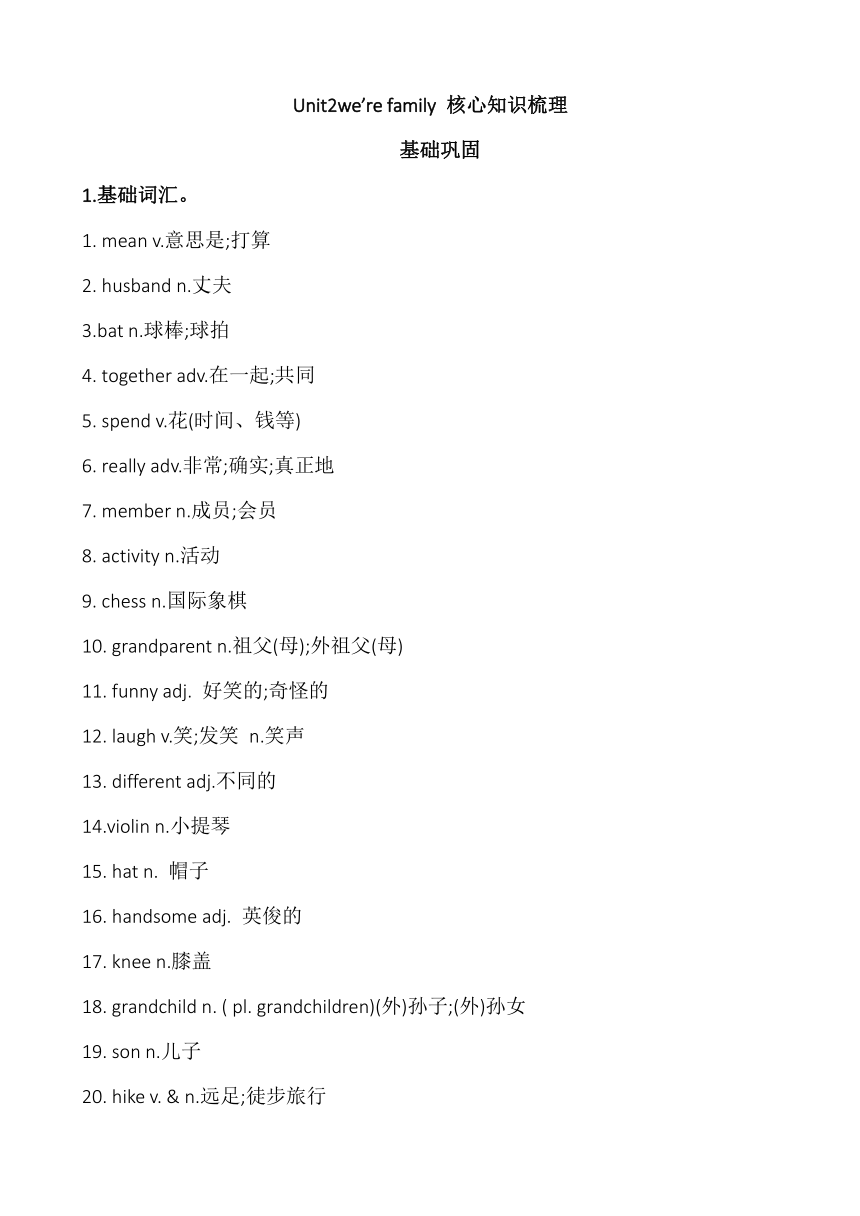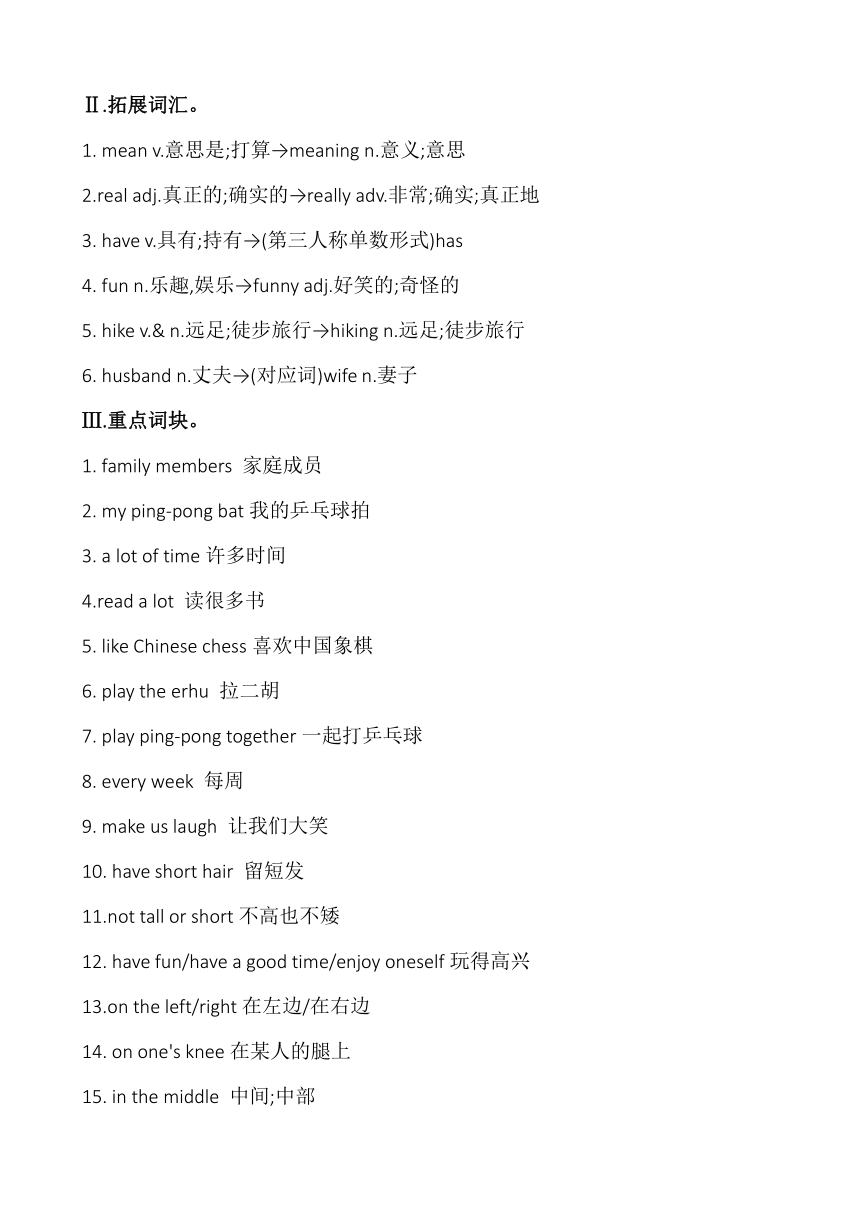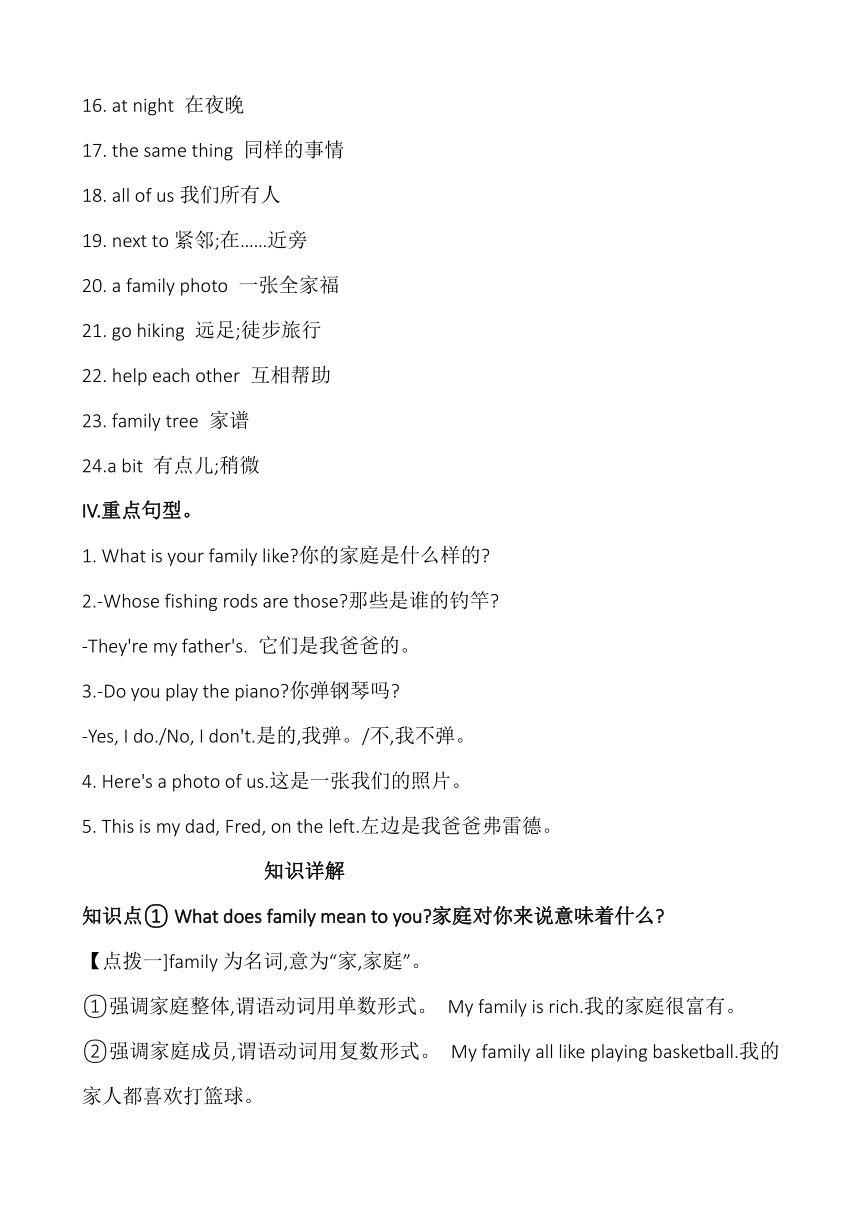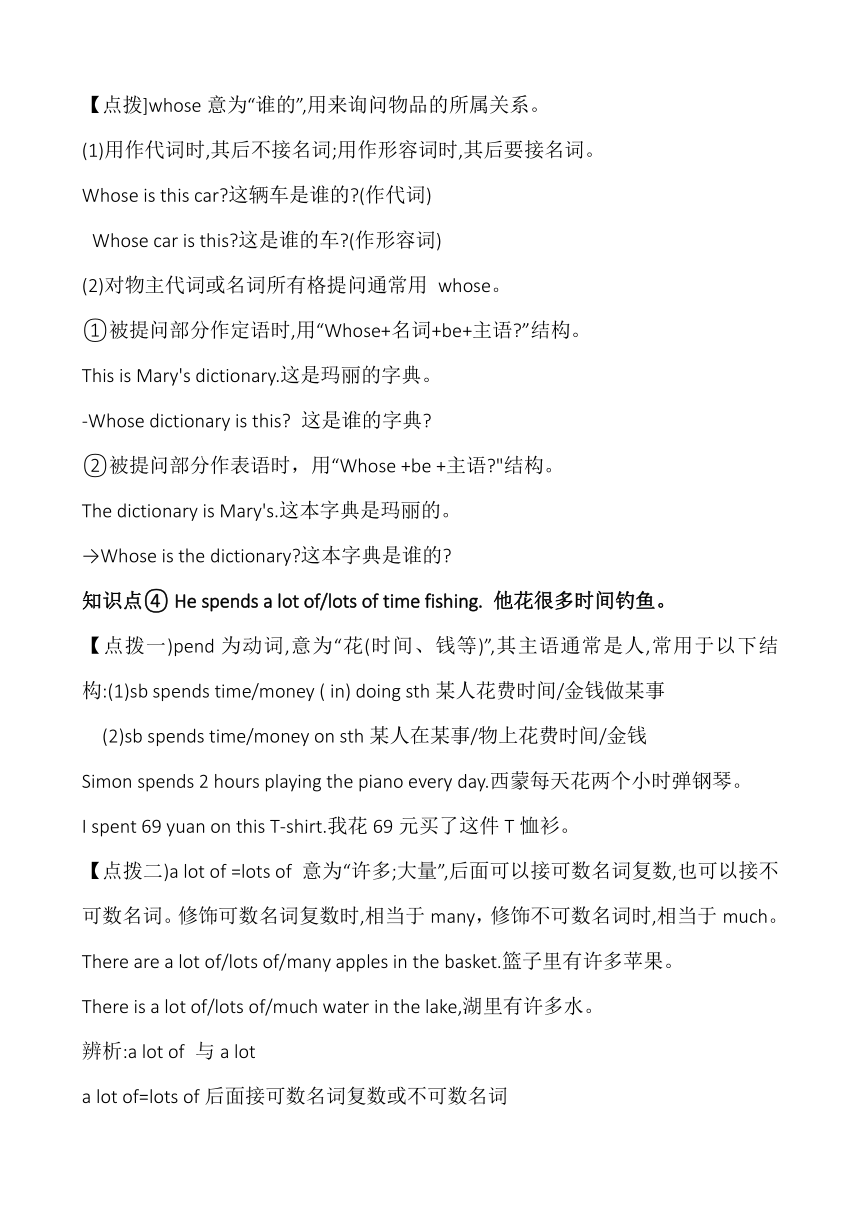Unit2 We're Family核心知识梳理人教版(2024)七年级英语上册
文档属性
| 名称 | Unit2 We're Family核心知识梳理人教版(2024)七年级英语上册 |  | |
| 格式 | docx | ||
| 文件大小 | 21.7KB | ||
| 资源类型 | 教案 | ||
| 版本资源 | 人教版 | ||
| 科目 | 英语 | ||
| 更新时间 | 2025-08-24 10:40:43 | ||
图片预览





文档简介
Unit2we’re family 核心知识梳理
基础巩固
1.基础词汇。
1. mean v.意思是;打算
2. husband n.丈夫
3.bat n.球棒;球拍
4. together adv.在一起;共同
5. spend v.花(时间、钱等)
6. really adv.非常;确实;真正地
7. member n.成员;会员
8. activity n.活动
9. chess n.国际象棋
10. grandparent n.祖父(母);外祖父(母)
11. funny adj. 好笑的;奇怪的
12. laugh v.笑;发笑 n.笑声
13. different adj.不同的
14.violin n.小提琴
15. hat n. 帽子
16. handsome adj. 英俊的
17. knee n.膝盖
18. grandchild n. ( pl. grandchildren)(外)孙子;(外)孙女
19. son n.儿子
20. hike v. & n.远足;徒步旅行
Ⅱ.拓展词汇。
1. mean v.意思是;打算→meaning n.意义;意思
2.real adj.真正的;确实的→really adv.非常;确实;真正地
3. have v.具有;持有→(第三人称单数形式)has
4. fun n.乐趣,娱乐→funny adj.好笑的;奇怪的
5. hike v.& n.远足;徒步旅行→hiking n.远足;徒步旅行
6. husband n.丈夫→(对应词)wife n.妻子
Ⅲ.重点词块。
1. family members 家庭成员
2. my ping-pong bat我的乒乓球拍
3. a lot of time许多时间
4.read a lot 读很多书
5. like Chinese chess喜欢中国象棋
6. play the erhu 拉二胡
7. play ping-pong together一起打乒乓球
8. every week 每周
9. make us laugh 让我们大笑
10. have short hair 留短发
11.not tall or short不高也不矮
12. have fun/have a good time/enjoy oneself玩得高兴
13.on the left/right在左边/在右边
14. on one's knee在某人的腿上
15. in the middle 中间;中部
16. at night 在夜晚
17. the same thing 同样的事情
18. all of us我们所有人
19. next to紧邻;在……近旁
20. a family photo 一张全家福
21. go hiking 远足;徒步旅行
22. help each other 互相帮助
23. family tree 家谱
24.a bit 有点儿;稍微
IV.重点句型。
1. What is your family like 你的家庭是什么样的
2.-Whose fishing rods are those 那些是谁的钓竿
-They're my father's. 它们是我爸爸的。
3.-Do you play the piano 你弹钢琴吗
-Yes, I do./No, I don't.是的,我弹。/不,我不弹。
4. Here's a photo of us.这是一张我们的照片。
5. This is my dad, Fred, on the left.左边是我爸爸弗雷德。
知识详解
知识点① What does family mean to you 家庭对你来说意味着什么
【点拨一]family为名词,意为“家,家庭”。
①强调家庭整体,谓语动词用单数形式。 My family is rich.我的家庭很富有。
②强调家庭成员,谓语动词用复数形式。 My family all like playing basketball.我的家人都喜欢打篮球。
【点拨二](1)mean作动词,意为“意思是”,后接名词、动词的-ing形式或从句。其名词形式为 meaning。
Red means good luck in China.红色在中国意味着好运。
What does the sentence mean = What's the meaning of the sentence
这个句子的意思是什么
What do you mean by doing that 你那样做是什么意思
mean意为“打算”。
常用搭配: mean to do sth打算做某事。
I mean to call on you tomorrow.我打算明天看望你。
(3)mean 意为“意味着”,其后常接名词或动词-ing形式作宾语。
It means wasting more time.那意味着浪费更多的时间。
知识点② What is your family like 你的家庭是什么样的
【点拨]该句型多用来询问某物的特征或某人的性格、品质等。
-What's your school like 你的学校是什么样的
-It's large and beautiful.它又大又漂亮。
-What's he like 他是个什么样的人
-He is kind and outgoing.他很友善,也很外向。
【拓展]“What+be+sb+like ”还可用来询问人的相貌,同义表达为“What does sb look like ”。
-What does your father look like/What is your father like 你爸爸长什么样
-He's tall and strong.他又高又壮。
知识点③ -Whose are they 它们是谁的
-Well, this is my ping-pong bat ...嗯,这是我的乒乓球拍……
【点拨]whose意为“谁的”,用来询问物品的所属关系。
(1)用作代词时,其后不接名词;用作形容词时,其后要接名词。
Whose is this car 这辆车是谁的 (作代词)
Whose car is this 这是谁的车 (作形容词)
(2)对物主代词或名词所有格提问通常用 whose。
①被提问部分作定语时,用“Whose+名词+be+主语 ”结构。
This is Mary's dictionary.这是玛丽的字典。
-Whose dictionary is this 这是谁的字典
②被提问部分作表语时,用“Whose +be +主语 "结构。
The dictionary is Mary's.这本字典是玛丽的。
→Whose is the dictionary 这本字典是谁的
知识点④ He spends a lot of/lots of time fishing. 他花很多时间钓鱼。
【点拨一)pend为动词,意为“花(时间、钱等)”,其主语通常是人,常用于以下结构:(1)sb spends time/money ( in) doing sth某人花费时间/金钱做某事
(2)sb spends time/money on sth某人在某事/物上花费时间/金钱
Simon spends 2 hours playing the piano every day.西蒙每天花两个小时弹钢琴。
I spent 69 yuan on this T-shirt.我花69元买了这件T恤衫。
【点拨二)a lot of =lots of 意为“许多;大量”,后面可以接可数名词复数,也可以接不可数名词。修饰可数名词复数时,相当于many,修饰不可数名词时,相当于much。
There are a lot of/lots of/many apples in the basket.篮子里有许多苹果。
There is a lot of/lots of/much water in the lake,湖里有许多水。
辨析:a lot of 与a lot
a lot of=lots of后面接可数名词复数或不可数名词
a lot副词短语,意为“很,非常"、相当于“very much”,多与动词连用
Mary knows a lot about Chinese history, because she has a lot of Chinese friends. And they help her a lot.玛丽对中国历史了解颇深,因为她有很多中国朋友。他们帮了她很多。
知识点5 She can play it really/very well! 她弹得非常好!
【点拨一]really 为副词,意为“非常;确实;真正地”,修饰动词、形容词或副词,起加强语气的作用。位于助动词、系动词后面,实义动词,形容同、副词前面。
This book is really good.这本书的确好。(修饰形容词)
I really love the dog.我非常喜欢这只狗。(修饰动词)
[拓展]really 还可以单独使用,表示感兴趣、惊奇、怀疑等,读时用升调,意为“真的吗”。
-The film will be on this Saturday.这部电影即将在本周六上映。
-Oh,really 哦,真的吗
【点拨二]well 为副词,意为“好;令人满意地”,常用来修饰动词(短语)。
Steve learns English well.史蒂夫英语学得很好。
-I get first prize in the game.我在比赛中得了一等奖。
-Well done.干得好。
【拓展]well 的其他用法:
感叹词意为“嗯,好吧”表示勉强同意Well, you may be right.,好吧,你也许是对的。
意为“啊,好啦”表示惊奇,愤怒等情绪Well, what a nice gift!啊.多么漂亮的礼物啊!形容词 意为“健康,身体好”,feel well 意为“感觉身体不错”
I don't feel well.我感觉身体不太好。
名词 意为“井,水井” The well is very deep.这口井很深。
知识点6 How many people are there in your family 你家里有几口人
【点拨一]“How many+可数名词复数+are there+介词短语 ”意为“……有多少…… ”,此句是 there be句型的特殊疑问句形式,用来询问某人或物的数量。其答语为“There be+数字(+可数名词+介词短语).”,也可直接回答数字。
-How many pens are there on the desk 课桌上有几支钢笔
-There are three./Three.三支。
【点拨二]people 为集合名词,表示复数意义,作主语时谓语动词用复数形式。其前可用基数词(大于1)或many、a lot of 等修饰。表示“一个人”时,常用a/one person。 There are a lot of people in the park.公园里有许多人。
知识点⑦ Here's a photo of us.这是一张我们的照片。
【点拨]“Here is/are..”意为“这是……;这里有……”,该句型为倒装结构,用于介绍某人或某物。正常语序为“... is/are here. ” Here is my jacket.这是我的夹克衫。
Here are some ideas to help you.这里有一些可以帮到你的主意。
【拓展]Here’s是Hereis的缩写形式。用于介绍或引人话题。
具体用法:(1)宣布消息Here’s some good news.这儿有一些好消息。
(2)介绍某人或某物 Here's my friend.这是我的朋友。
(3)给予物品Here are your tickets.这是你们的票。
知 识 点 8.. but I think they say the same thing to all of us!
但我觉得他们对我们所有人都是这么说的!
【点拨一]say为动词,意为“说;讲”,其后可直接跟说的内容。
常用搭配: say sth to sb对某人说某事 say no to sb 拒绝某人
say hello/hi to sb向某人问好 say goodbye to sb向某人道别
say thanks to sb向某人道谢 say sorry to sb向某人道歉
Please say it in English.请用英语说它。
I say hello to him with a smile.我微笑着向他问好。
It's time to say goodbye to my primary school life.该和我的小学生活说再见了。
【点拨二]all 为代词,意为“所有;全部”,用于三者或三者以上,常用于“all of ...”结构。
All of them ( =They all) like English movies very much.他们都非常喜欢英文电影。
【拓展]all用作形容词时,意为“所有的;全部的”,修饰可数名词复数或不可数名词。“all+限定词( the、these、this、my等)+名词”表示“所有的……”。
All the students are having a PE lesson in the playground.
所有的学生都在操场上上体育课。
语法聚焦“名词+’s”所有格
“名词+’s”所有格主要用于表示有生命事物的名词的所属关系。常用于以下情况:
1.单数名词后加“’s”(以-s结尾的人名后加“”或“’s”均可)。
my sister's book 我姐姐的书
James’/James's bike詹姆斯的自行车
2.以-s 结尾的复数名词只加“”,不以-s结尾的复数名词通常加“’s”。
the three girls' father 这三个女孩的父亲
the three children's father这三个孩子的父亲
3.表示几个人共有,仅在最后一个人的名字后加“’s”;表示各自所有时,应在各个名字后加“’s”。
Mary and Jane's car玛丽和简的汽车(她们共有的汽车)
Mary's and Jane's cars玛丽和简的汽车(她们各自的汽车)
4.’s所有格后的名词为住所、商店或办公场所等时,该名词通常可省略。
-Where are you going 你要去哪里
- To Tom's.去汤姆家。
含实义动词的一般现在时
一般现在时可以表示现在的状态,还可以表示经常发生的或习惯性的动作,也可以表示主语具备的性格和能力等。本单元主要讲解实义动词在一般现在时中的基本用法。
含实义动词的一般现在时的句型
句式 结构 例句
肯定句 主语+动词第三人称 He plays basketball every day.
单数形式/动词原形+其他. 他每天都打篮球。
否定句 主语+ don’t/doesn't + They don't like to go shopping.
动词原形+其他. 他们不喜欢去购物。
一般疑问句及 Do/Does+主语+动词 -Does his father wear glasses
其简略回答 原形+其他 他爸爸戴眼镜吗
肯定回答:Yes主语+do/does. -Yes, he does.是 的,他戴。
否定回答:No,主语+don’t/doesn't. -No, he doesn't./不,他不戴。
[注意]
①肯定句主语为第三人称单数时,谓语动词的词尾要加-s/-es。
He/She likes oranges.他/她喜欢橙子。
②在否定句和疑问句中,do/does后面的动词要用原形。
He/She doesn't like oranges.他/她不喜欢橙子。
③简略回答的主语和助动词跟随问句,用什么问,就用什么答(问句中主语为you 时,回答用 I/we)。
-Does he like oranges 他喜欢橙子吗
-Yes,he does./No, he doesn't.是的,他喜欢。/不,他不喜欢。
基础巩固
1.基础词汇。
1. mean v.意思是;打算
2. husband n.丈夫
3.bat n.球棒;球拍
4. together adv.在一起;共同
5. spend v.花(时间、钱等)
6. really adv.非常;确实;真正地
7. member n.成员;会员
8. activity n.活动
9. chess n.国际象棋
10. grandparent n.祖父(母);外祖父(母)
11. funny adj. 好笑的;奇怪的
12. laugh v.笑;发笑 n.笑声
13. different adj.不同的
14.violin n.小提琴
15. hat n. 帽子
16. handsome adj. 英俊的
17. knee n.膝盖
18. grandchild n. ( pl. grandchildren)(外)孙子;(外)孙女
19. son n.儿子
20. hike v. & n.远足;徒步旅行
Ⅱ.拓展词汇。
1. mean v.意思是;打算→meaning n.意义;意思
2.real adj.真正的;确实的→really adv.非常;确实;真正地
3. have v.具有;持有→(第三人称单数形式)has
4. fun n.乐趣,娱乐→funny adj.好笑的;奇怪的
5. hike v.& n.远足;徒步旅行→hiking n.远足;徒步旅行
6. husband n.丈夫→(对应词)wife n.妻子
Ⅲ.重点词块。
1. family members 家庭成员
2. my ping-pong bat我的乒乓球拍
3. a lot of time许多时间
4.read a lot 读很多书
5. like Chinese chess喜欢中国象棋
6. play the erhu 拉二胡
7. play ping-pong together一起打乒乓球
8. every week 每周
9. make us laugh 让我们大笑
10. have short hair 留短发
11.not tall or short不高也不矮
12. have fun/have a good time/enjoy oneself玩得高兴
13.on the left/right在左边/在右边
14. on one's knee在某人的腿上
15. in the middle 中间;中部
16. at night 在夜晚
17. the same thing 同样的事情
18. all of us我们所有人
19. next to紧邻;在……近旁
20. a family photo 一张全家福
21. go hiking 远足;徒步旅行
22. help each other 互相帮助
23. family tree 家谱
24.a bit 有点儿;稍微
IV.重点句型。
1. What is your family like 你的家庭是什么样的
2.-Whose fishing rods are those 那些是谁的钓竿
-They're my father's. 它们是我爸爸的。
3.-Do you play the piano 你弹钢琴吗
-Yes, I do./No, I don't.是的,我弹。/不,我不弹。
4. Here's a photo of us.这是一张我们的照片。
5. This is my dad, Fred, on the left.左边是我爸爸弗雷德。
知识详解
知识点① What does family mean to you 家庭对你来说意味着什么
【点拨一]family为名词,意为“家,家庭”。
①强调家庭整体,谓语动词用单数形式。 My family is rich.我的家庭很富有。
②强调家庭成员,谓语动词用复数形式。 My family all like playing basketball.我的家人都喜欢打篮球。
【点拨二](1)mean作动词,意为“意思是”,后接名词、动词的-ing形式或从句。其名词形式为 meaning。
Red means good luck in China.红色在中国意味着好运。
What does the sentence mean = What's the meaning of the sentence
这个句子的意思是什么
What do you mean by doing that 你那样做是什么意思
mean意为“打算”。
常用搭配: mean to do sth打算做某事。
I mean to call on you tomorrow.我打算明天看望你。
(3)mean 意为“意味着”,其后常接名词或动词-ing形式作宾语。
It means wasting more time.那意味着浪费更多的时间。
知识点② What is your family like 你的家庭是什么样的
【点拨]该句型多用来询问某物的特征或某人的性格、品质等。
-What's your school like 你的学校是什么样的
-It's large and beautiful.它又大又漂亮。
-What's he like 他是个什么样的人
-He is kind and outgoing.他很友善,也很外向。
【拓展]“What+be+sb+like ”还可用来询问人的相貌,同义表达为“What does sb look like ”。
-What does your father look like/What is your father like 你爸爸长什么样
-He's tall and strong.他又高又壮。
知识点③ -Whose are they 它们是谁的
-Well, this is my ping-pong bat ...嗯,这是我的乒乓球拍……
【点拨]whose意为“谁的”,用来询问物品的所属关系。
(1)用作代词时,其后不接名词;用作形容词时,其后要接名词。
Whose is this car 这辆车是谁的 (作代词)
Whose car is this 这是谁的车 (作形容词)
(2)对物主代词或名词所有格提问通常用 whose。
①被提问部分作定语时,用“Whose+名词+be+主语 ”结构。
This is Mary's dictionary.这是玛丽的字典。
-Whose dictionary is this 这是谁的字典
②被提问部分作表语时,用“Whose +be +主语 "结构。
The dictionary is Mary's.这本字典是玛丽的。
→Whose is the dictionary 这本字典是谁的
知识点④ He spends a lot of/lots of time fishing. 他花很多时间钓鱼。
【点拨一)pend为动词,意为“花(时间、钱等)”,其主语通常是人,常用于以下结构:(1)sb spends time/money ( in) doing sth某人花费时间/金钱做某事
(2)sb spends time/money on sth某人在某事/物上花费时间/金钱
Simon spends 2 hours playing the piano every day.西蒙每天花两个小时弹钢琴。
I spent 69 yuan on this T-shirt.我花69元买了这件T恤衫。
【点拨二)a lot of =lots of 意为“许多;大量”,后面可以接可数名词复数,也可以接不可数名词。修饰可数名词复数时,相当于many,修饰不可数名词时,相当于much。
There are a lot of/lots of/many apples in the basket.篮子里有许多苹果。
There is a lot of/lots of/much water in the lake,湖里有许多水。
辨析:a lot of 与a lot
a lot of=lots of后面接可数名词复数或不可数名词
a lot副词短语,意为“很,非常"、相当于“very much”,多与动词连用
Mary knows a lot about Chinese history, because she has a lot of Chinese friends. And they help her a lot.玛丽对中国历史了解颇深,因为她有很多中国朋友。他们帮了她很多。
知识点5 She can play it really/very well! 她弹得非常好!
【点拨一]really 为副词,意为“非常;确实;真正地”,修饰动词、形容词或副词,起加强语气的作用。位于助动词、系动词后面,实义动词,形容同、副词前面。
This book is really good.这本书的确好。(修饰形容词)
I really love the dog.我非常喜欢这只狗。(修饰动词)
[拓展]really 还可以单独使用,表示感兴趣、惊奇、怀疑等,读时用升调,意为“真的吗”。
-The film will be on this Saturday.这部电影即将在本周六上映。
-Oh,really 哦,真的吗
【点拨二]well 为副词,意为“好;令人满意地”,常用来修饰动词(短语)。
Steve learns English well.史蒂夫英语学得很好。
-I get first prize in the game.我在比赛中得了一等奖。
-Well done.干得好。
【拓展]well 的其他用法:
感叹词意为“嗯,好吧”表示勉强同意Well, you may be right.,好吧,你也许是对的。
意为“啊,好啦”表示惊奇,愤怒等情绪Well, what a nice gift!啊.多么漂亮的礼物啊!形容词 意为“健康,身体好”,feel well 意为“感觉身体不错”
I don't feel well.我感觉身体不太好。
名词 意为“井,水井” The well is very deep.这口井很深。
知识点6 How many people are there in your family 你家里有几口人
【点拨一]“How many+可数名词复数+are there+介词短语 ”意为“……有多少…… ”,此句是 there be句型的特殊疑问句形式,用来询问某人或物的数量。其答语为“There be+数字(+可数名词+介词短语).”,也可直接回答数字。
-How many pens are there on the desk 课桌上有几支钢笔
-There are three./Three.三支。
【点拨二]people 为集合名词,表示复数意义,作主语时谓语动词用复数形式。其前可用基数词(大于1)或many、a lot of 等修饰。表示“一个人”时,常用a/one person。 There are a lot of people in the park.公园里有许多人。
知识点⑦ Here's a photo of us.这是一张我们的照片。
【点拨]“Here is/are..”意为“这是……;这里有……”,该句型为倒装结构,用于介绍某人或某物。正常语序为“... is/are here. ” Here is my jacket.这是我的夹克衫。
Here are some ideas to help you.这里有一些可以帮到你的主意。
【拓展]Here’s是Hereis的缩写形式。用于介绍或引人话题。
具体用法:(1)宣布消息Here’s some good news.这儿有一些好消息。
(2)介绍某人或某物 Here's my friend.这是我的朋友。
(3)给予物品Here are your tickets.这是你们的票。
知 识 点 8.. but I think they say the same thing to all of us!
但我觉得他们对我们所有人都是这么说的!
【点拨一]say为动词,意为“说;讲”,其后可直接跟说的内容。
常用搭配: say sth to sb对某人说某事 say no to sb 拒绝某人
say hello/hi to sb向某人问好 say goodbye to sb向某人道别
say thanks to sb向某人道谢 say sorry to sb向某人道歉
Please say it in English.请用英语说它。
I say hello to him with a smile.我微笑着向他问好。
It's time to say goodbye to my primary school life.该和我的小学生活说再见了。
【点拨二]all 为代词,意为“所有;全部”,用于三者或三者以上,常用于“all of ...”结构。
All of them ( =They all) like English movies very much.他们都非常喜欢英文电影。
【拓展]all用作形容词时,意为“所有的;全部的”,修饰可数名词复数或不可数名词。“all+限定词( the、these、this、my等)+名词”表示“所有的……”。
All the students are having a PE lesson in the playground.
所有的学生都在操场上上体育课。
语法聚焦“名词+’s”所有格
“名词+’s”所有格主要用于表示有生命事物的名词的所属关系。常用于以下情况:
1.单数名词后加“’s”(以-s结尾的人名后加“”或“’s”均可)。
my sister's book 我姐姐的书
James’/James's bike詹姆斯的自行车
2.以-s 结尾的复数名词只加“”,不以-s结尾的复数名词通常加“’s”。
the three girls' father 这三个女孩的父亲
the three children's father这三个孩子的父亲
3.表示几个人共有,仅在最后一个人的名字后加“’s”;表示各自所有时,应在各个名字后加“’s”。
Mary and Jane's car玛丽和简的汽车(她们共有的汽车)
Mary's and Jane's cars玛丽和简的汽车(她们各自的汽车)
4.’s所有格后的名词为住所、商店或办公场所等时,该名词通常可省略。
-Where are you going 你要去哪里
- To Tom's.去汤姆家。
含实义动词的一般现在时
一般现在时可以表示现在的状态,还可以表示经常发生的或习惯性的动作,也可以表示主语具备的性格和能力等。本单元主要讲解实义动词在一般现在时中的基本用法。
含实义动词的一般现在时的句型
句式 结构 例句
肯定句 主语+动词第三人称 He plays basketball every day.
单数形式/动词原形+其他. 他每天都打篮球。
否定句 主语+ don’t/doesn't + They don't like to go shopping.
动词原形+其他. 他们不喜欢去购物。
一般疑问句及 Do/Does+主语+动词 -Does his father wear glasses
其简略回答 原形+其他 他爸爸戴眼镜吗
肯定回答:Yes主语+do/does. -Yes, he does.是 的,他戴。
否定回答:No,主语+don’t/doesn't. -No, he doesn't./不,他不戴。
[注意]
①肯定句主语为第三人称单数时,谓语动词的词尾要加-s/-es。
He/She likes oranges.他/她喜欢橙子。
②在否定句和疑问句中,do/does后面的动词要用原形。
He/She doesn't like oranges.他/她不喜欢橙子。
③简略回答的主语和助动词跟随问句,用什么问,就用什么答(问句中主语为you 时,回答用 I/we)。
-Does he like oranges 他喜欢橙子吗
-Yes,he does./No, he doesn't.是的,他喜欢。/不,他不喜欢。
同课章节目录
